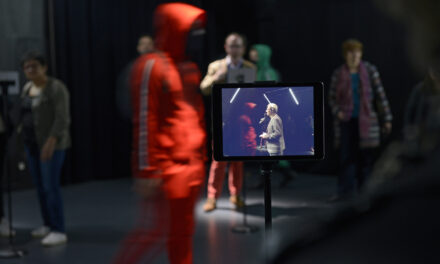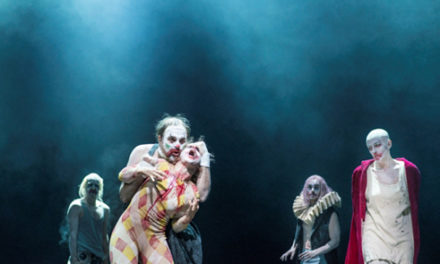Hong Kong’s branding campaign as “Asia’s World City” sings the praises of its liveability, connectivity, entrepreneurialism and more. But only the sunniest observers of the city’s tumultuous politics and crippling pandemic-related isolation wouldn’t hedge that optimism with some serious questions about the future. Prosperity, security and international influence are all rooted in the powerful trifecta of political values, culture and foreign policy that is soft power, or a country’s ability to engage with global audiences. Soft power leaders like the United Kingdom and France know that culture is key to their ability to sway proverbial hearts and minds in their favour. Yet the pandemic has brought about a sea of change in the way the performing arts industry approaches everything from networking to touring.
Even in that context, however, Hong Kong remains an outlier. Its cultural sector has been exhausted by two years of zero-Covid policies, and the industry remains hamstrung as much by fears of renewed pandemic closures as by anxiety over the limits of free speech and creativity under the National Security Law. Policy announcements reveal that the Hong Kong government is moving to invest in capacity-building technology for arts groups while grappling with longstanding structural inefficiencies – as well as new directives from Beijing. Public understanding of these initiatives is low, however, even among arts professionals, who await the change of Chief Executive on July 1 in a climate of indecision.
It was against this background that the International Society for the Performing Arts (ISPA), an influential network of 500 performing arts leaders, held its midyear congress in Hong Kong in May. Forced to pivot from a hybrid format to a completely virtual event, the Hong Kong Congress attracted only half as many delegates as similar events in previous years. Half of those attendees were from the Leisure and Cultural Services Department (LCSD), which organised the conference. A top industry official in Hong Kong speaking at the congress was at pains to reassure international delegates that “everyone is flourishing in Hong Kong,” but interviews and informal conversations with industry players reflect a more studied pragmatism as arts professionals take stock of the new normal: in the last three years, Hong Kong has suffered potentially long-term reputational damage affecting its credibility and reliability among professionals and interest among artists and audiences.
That realisation is dawning within a broader context of China’s aspirations for Hong Kong. The nation’s 14th Five-Year Plan (2021-25) directs Hong Kong to beef up its stature as an “East-West platform of international cultural exchange.” The announcement puzzled many arts professionals here; East-West exchange is, after all, Hong Kong’s brand. One well-placed observer considered the announcement a “not very creative” response to the challenges they currently face. (The observer spoke off the record, in order to express themselves freely, which was the case for many of the people interviewed for this article.) The intended nuance, if there is one, appears to reside in the context of Greater Bay Area building and efforts on multiple fronts to square Hong Kong’s future with that of its closest mainland neighbours.
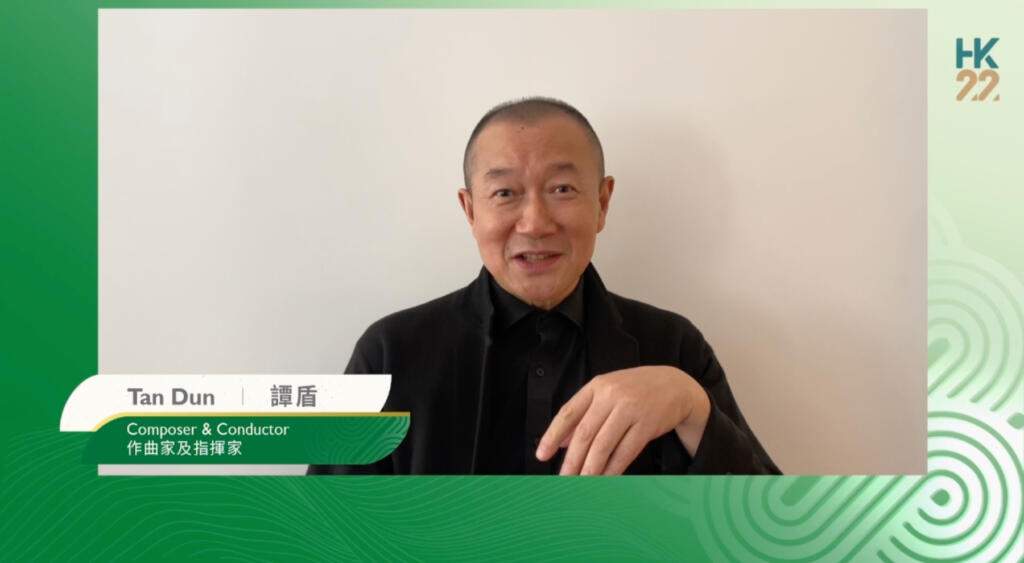
Tan Dun delivered the ISPA Hong Kong Congress’s first keynote address, urging delegates to remember that artists are “creators of medicine for the soul.” PC: International Society of the Performing Arts
New culture bureau, old questions
If the question on everyone’s mind is, “Where do we go from here?” it’s a good bet that whoever answers it will be seated in the new Culture, Sports and Tourism Bureau (CSTB) that was announced in January. The move has long been called for to streamline the existing constellation of government and statutory bodies. However, it calls into question the fate of the two main agencies that support artists: the Arts Development Council (ADC), which provides operational and project funding to small and medium arts groups; and the LCSD, which manages the vast majority of the city’s performing arts venues.
The CTSB will separate the Home Affairs Bureau from its arts and culture portfolio and force the latter into closer “synergy,” as some are describing the reorganisation, with tourism and the creative industries, which will similarly be removed from the purview of the Commerce and Economic Development Bureau. While major players such as the West Kowloon Cultural District (WKCD) have said they look forward to more “effective collaboration” with the government, the rumour that small and medium arts groups are hearing is that a centralised culture bureau will inevitably come with increased oversight of artists, perhaps even a censorship office. That, along with the prospect of having to navigate a new bureaucratic structure, is leading some arts groups to explore options to exist independently of government subsidies.
Industry professionals are also expressing doubt whether the new bureau will have a clear strategic vision, a criticism that has also been aimed at the Home Affairs Bureau over the years. This is of immediate concern, as one of the first priorities of the new bureau will be to spearhead a Hong Kong Performing Arts Market, which has already been earmarked some HK$42 million in the government’s 2022-23 budget, and that is being pushed forward to validate Hong Kong’s “new” East-West arts and culture platform.
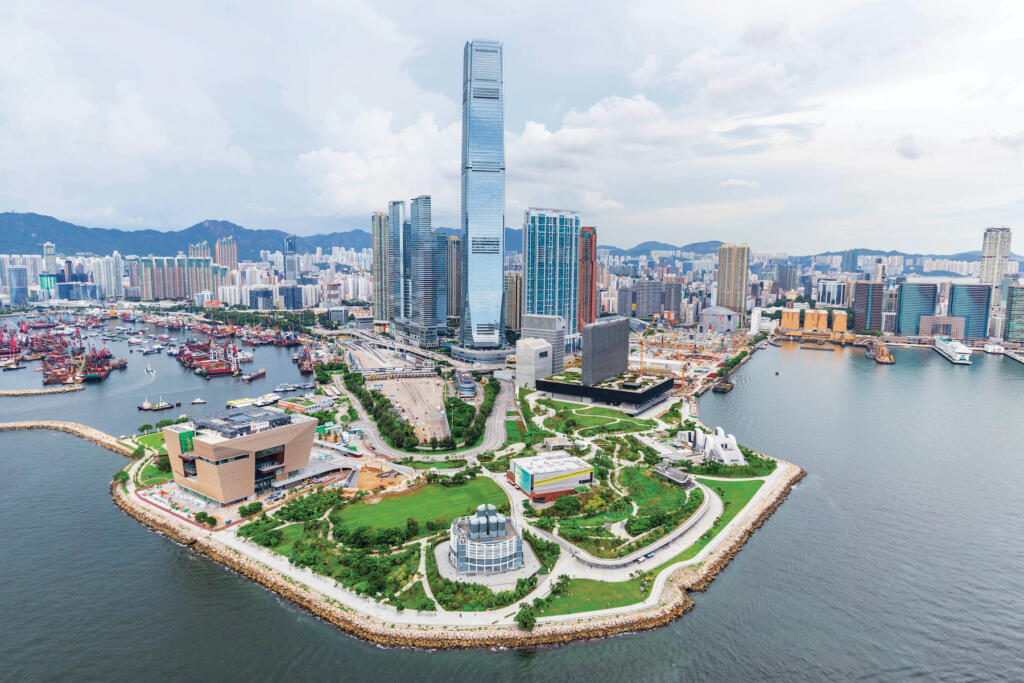
West Kowloon Cultural District from above. PC: WKCDA
West Kowloon, gateway to the mainland
The cornerstone of that East-West vision is the West Kowloon Cultural District. But rather than go from strength to strength after the launch of its live performing arts activities in 2019, the district and its governing authority have instead hit—or created—setback after setback. Since the start of the pandemic, Freespace, a black box theatre for experimental performance, and the Xiqu Centre, Hong Kong’s home for Cantonese opera, have been closed for 330 days. The WKCD Authority ran a HK$491 million operating deficit in 2020-21 and has blown through most of the government’s HK$21.6 billion endowment, leaving planned venues like the dance-focused Lyric Theatre, with a tentative opening date in 2024, still far from completion.
In the face of financial difficulties of that magnitude, the decision not to fill the positions left empty by Alison Friedman, the former Artistic Director of Performing Arts, and Low Kee Hong, Head of Theatre, who both resigned in 2021, can be conveniently ascribed to budget concerns. However, the leadership void leaves Paul Tam, WKCDA’s Executive Director for Performing Arts, to soldier on alone, for better or for worse. With a career in classical music, Tam has been described as a “safe choice” for the authority as he is unlikely to have a bold curatorial vision.
Despite the District’s challenges, a presentation by WKCDA CEO Betty Fung Ching Suk-yee during the ISPA congress stressed West Kowloon’s ambitions to position itself as the nexus of Hong Kong’s East-West cultural exchange hub. Fung emphasised the WKCD’s “superb connectivity” with the mainland thanks to its proximity to the Guangzhou–Shenzhen–Hong Kong Express Rail Link. Capitalising on the 20-minute travel time between West Kowloon Station and Shenzhen (once the border reopens), the authority is aiming to lure Shenzhen’s 17-million-strong market to the WKCD for a show in less time than it would take for a Hongkonger in Chai Wan to travel to the Hong Kong Cultural Centre in Tsim Sha Tsui.
That message was echoed by Ding Zhongyuen, Head of the Preparatory Office of Shenzhen’s new Opera House, which is on schedule to open in 2026. A sprawling 223,000-square-metre facility designed by Jean Nouvel on reclaimed land along the shore of Shenzhen Bay, the site will include a 2,100-seat Grand Opera House which, Ding said, aims to attract Hong Kong’s more international, Western opera fans while offering “other services” to Shenzhen audiences in its auxiliary zones and smaller venues.
Whether, in some near future, Greater Bay Area connectivity will be as much a reality as it is policy today was not in doubt at the congress. What did raise some eyebrows was the WKCD’s vision of the future, which sounded almost monomaniacal at times. Fung stressed that the district has “global ambitions” for “a higher level of international cultural exchange” than can be offered anywhere else in Hong Kong. To meet that goal, WKCDA is working with the Hong Kong Tourism Board to promote the district to the Greater Bay Area’s 86 million residents. West Kowloon, Fung said, wants to welcome “everyone under one roof.” Its huge ambitions are dwarfed not only by its astounding budget deficit but also by the massive market it is eyeing.
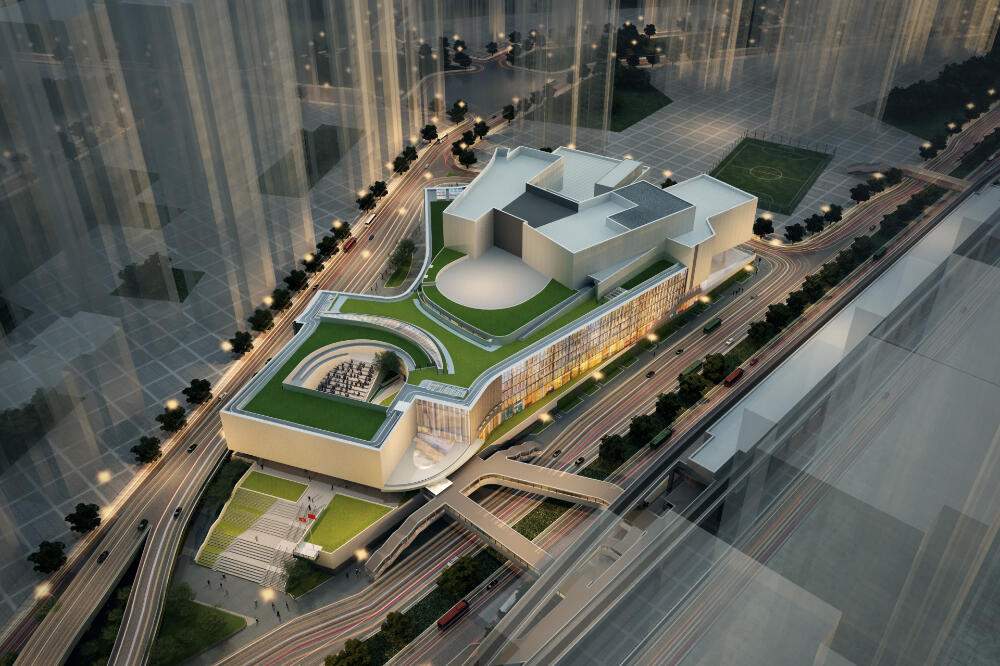
A model of the upcoming East Kowloon Cultural Centre. PC: EKCC
Arts tech: everyone’s saviour?
If West Kowloon is looking to be the towers in Hong Kong’s East-West bridge, that infrastructure will not be built without state-of-the-art technology. Yet already there are many voices questioning the government’s lack of a clear strategy and vision for this move, even while there is general consensus that “arts tech”—as the integration of the arts and digital technologies is known here—is the only way to put Hong Kong on an equal playing field with its global peers.The latest government budgets reflect these new priorities. An initial earmarking of HK$100 million in 2020-21 was intended to “promote the integration of arts and technology,” which led to the creation of an interagency task force to “formulate strategies and measures to develop and promote Arts Tech.” The 2022-23 Budget allocates a further HK$30 million to the city’s nine major performing arts groups and HK$10 million to small and medium arts groups “to apply arts technology to enrich their stage production.”Nevertheless, the real heavy lifting of Hong Kong’s arts tech future has been delegated to the East Kowloon Cultural Centre (EKCC) which is slated to open in 2024. The HK$4 billion facility located in Ngau Tau Kok will include five performance spaces plus rehearsal rooms but its most awaited addition to Hong Kong’s performing arts will be a technology incubator able to experiment with AR, VR, 3D projections and more, thanks to an annual operating budget of HK$85 million. Construction is four years behind schedule, but in that time the LCSD has been vaunting the high tech wares of its newest venue through visits, conferences and e-blasts directed at arts groups. Moreover, besides its technological resources, which outclass those of all LCSD venues combined (even while these are slated for a HK$70 million update), the EKCC will be unique among them, and function closer to the WKCD’s model, in that it will be invested with a curatorial mission to commission local artists.Small and medium arts groups welcome the opportunities that a new producing body in Hong Kong may offer; however, some wonder if they will have the technological know-how and appropriate hardware and software to take advantage of the new facilities, or even get in the door at East Kowloon. Indeed, there are fears that an arts tech arms race may be looming, where artists who use digital technologies are prioritised for funding.Winsome Chow, Chief Executive of the Arts Development Council, said in an interview after the congress that artists need to be more forward-looking, estimating that 80 percent of Hong Kong arts groups “are still too involved with plays on stage,” in the belief that “the performing arts have to be performed and felt by audiences in live performances.” However, she sees a positive trend towards more hybrid models, meaning where artists and audiences may be both live and streamed or pre-recorded into the performance.
Some in the performing arts scene believe that government communication belies a deep-seated misunderstanding of how art and technology can most usefully join forces, speaking of adding technology to art or vice versa and “improving” whatever happens on a stage. Speaking at the ISPA congress, Manchester International Festival Artistic Director and Chief Executive John McGrath articulated a different discourse. While he insisted that theatre must evolve hand in hand with technology or risk becoming a “museum piece,” he also urged delegates to remember that the success of arts tech will rely, precisely, on sharing and feeling a live experience together. “There’s a lot of technology that is disembodying us,” he said, “but what’s interesting is how does theatre and technology in a way re-embody us.”
Where to go from here?
In the end, the answer to the question of where to go from here lies somewhere outside of Hong Kong’s performing arts ecology, in which there are only two species, artists and the government, and one of those is a megafauna. Absent from this equation are three necessary elements: independent producers and venues; private investment, as individual or foundational philanthropy; and a thriving fourth estate to offer critical reviews and drive conversation around the arts, its players and activities. All are essential to spark innovation and discourse. No matter what changes will come with the anticipated CTSB, in the current landscape, the government-artist power differential will remain the same.
The question for Hong Kong should be: does it want to be rich in cultural currency or continue to trade in other players’ arts products, as the entrepôt it has always been? Clearly, the smart bet is on cultural currency, which, as Stephen Armstrong, the Creative Director of Melbourne’s Asia TOPA festival once said and firmly believes, “will outlast, out-win, out-vote any amount of money.”
One way Hong Kong can jumpstart its cultural currency is by investing in small and medium arts groups. Major arts groups like Zuni Icosahedron, to name the biggest theatre group among Hong Kong’s nine “majors” and also its arts tech leader before the term was coined, are often looked to as innovation leaders. Yet independent artists also drive innovation, not only in the ways that technology understands the term, but in scrappy, nuts-and-bolts, can-do chutzpah that empowers the arts community at large to think outside of the box and create resilient strategies for making art. A helpful analogy is to compare them to teenagers in the way that demographic drives pop culture; like them, small arts groups are much closer to social and cultural trends and are looking to give them expression in new and unexpected ways.
There is currently a chorus of voices in Hong Kong that want to limit funding to small and medium arts groups, precisely to force them to be more “resilient,” along the lines of American artists, who do not receive national subsidies. The analogy misunderstands, however, that US artists make up the difference thanks to a multivalent arts ecology that is supported by millions of dollars in tax-free private philanthropy, given voice by a flourishing print and online media, and built on the creativity and curatorial vision of independent venues that seek to grow communities and audiences to the benefit of all. No ecosystem survives with just two species. Art worlds are, to quote the sociologist Howard S. Becker, “networks of people cooperating.”
Arts tech is also anticipated in Hong Kong as the key to audience development in the belief that, if you build it, they will come. Yet audiences are much more discerning than that logic implies, and will recognise the difference between novelty and necessity. As Tseng Sun-man, Professor of Practice in Music Management at Chinese University of Hong Kong, told ISPA delegates, there is a need for arts professionals in Hong Kong to rethink their relationship with audiences as more than just ticket buyers.
Hong Kong has remarkably low attendance rates for the performing arts: just 10 percent of Hong Kong people aged 15 to 74 years attended theatre in a 12-month period, seeing 1.7 shows per person, according to the ADC’s 2018 Arts Participation and Consumption Survey, the latest available data. (In comparison, 33.3 percent of New York City residents attended a Broadway production in 2018, a figure which does not include audiences to the city’s many other theatre offers.) That statistic speaks to a host of issues that are endemic to the current arts ecology, from a lack of arts education to an elitist offer still focused on classical music and ballet, as well as the problem of the LCSD’s unattractive venues and extremely short performance runs. In the short term, allowing for audience ownership of the arts conversation through public consultation on new initiatives, increased visibility for arts criticism, and opportunities for the public to participate in dialogues around these, would be a start to sustainably growing audiences, but that also assumes the existence of a free, non self-censoring public forum of ideas.
McGrath, of the Manchester International Festival, provided further guidance that could be heeded in Hong Kong. Arts tech is not merely a “new set of conventions,” but a new creative language, at the heart of which there has to be exploration of the “necessary relationship between site, experience of audiences and the questions that the artist is asking.” As Hong Kong responds to the challenges it faces, it’s essential to get that relationship right, so that Hong Kong can be a site of creation as much as a hub of exchange.
This article was originally posted on Zolima Citymag on June 23, 2022, and has been reposted with permission. To read the original article, click here.
This post was written by the author in their personal capacity.The opinions expressed in this article are the author’s own and do not reflect the view of The Theatre Times, their staff or collaborators.
This post was written by Molly Grogan.
The views expressed here belong to the author and do not necessarily reflect our views and opinions.


